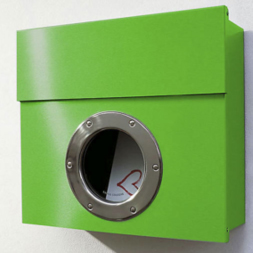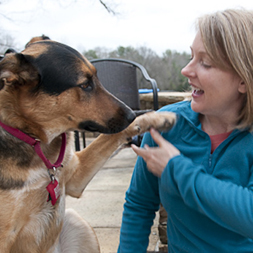One of the biggest hazards of working in the pet industry, especially at Petfinder, was hearing all the horror stories of pets escaping when people left on vacation, took them to a kennel or allowed pet sitters or dog walkers, or even service people, to come into their homes.
Over time, and many sad tales of lost pets, I became stranger and stranger about leaving my pets behind and ultimately only trusted my parents to “babysit.” I flew my parents in from Missouri whenever we had to travel without the dogs. Once I drove my dogs to my folks’ house (21 hours away) when they were unable to travel to us.
This worked well until my parents and I both ended up with dogs that look remarkably alike. Their easy-going, co-dependent and trustworthy Cooper and my party-animal, independent and very sneaky Jake could be littermates.
This is a problem because the last time my parents visited, Jake noticed that Cooper gets to go outside off-leash with my dad when he putters around the farm. So Jake began watching my dad for any sign of heading for the door and then he’d assume Cooper’s “heel” position and out they’d go! He tricked my folks a couple of times before anyone caught on.
An hour or so later someone would notice that it was Cooper on the sofa, rather than Jake, and you’d hear the most commonly spoken words in our house, “Has anyone seen Jake?” Invariably we’d go find my dad out on the farm somewhere and say, “Dad, have you seen Cooper?” And he’d say, “Well, he was right here a minute ago…” Unh-uh. Jake had done it again. Cooper was in on the couch, well-behaved dog that he is, and Jake would be on his way to the river to chase ripples or to the closest neighbor’s to make fun of their fenced-in dogs.
Thank goodness, Jake knows where he lives and, of course, he is microchipped but he wreaks havoc on his excursions by chasing horses, letting the other dogs out of the nearby dog park and finding dead and poopy things to roll on. Plus, as I’ve said in other blogs, I do live in fear that he’ll be “rescued” by a good Samaritan like me on one of his journeys, be driven far away and re-homed.
If you’ve become freakish about your dogs escaping, come stay with us a while. Jake is more than willing to provide immersion therapy for anyone that suffers from anxiety over freedom runs. No gate, fence or lock is Jake-proof. He watches and observes out of the corner of his eye, waiting for you to slip up, get distracted or forget to put the bungee over the fence latch or re-attach the electric wire that we’ve run along the top of our fence.
No service people, visitors or relatives have escaped his trickery. Over time his regular visitors eventually throw up their hands apologetically and say, “He’ll be back, right?” But if you visit, don’t bring your pets. He’ll teach them some incredibly disturbing tricks and take them on a freedom run.
Here are my top picks for making it easier to trust your visitors if you have a sneaky, bolting dog:
1. Have a well-behaved dog: Using positive reinforcement, train your dog or cat to sit and stay before someone opens a door. Okay, I have to include this as my top choice because it is politically correct. Let’s face it. Jake knows this trick and uses it against all of our first-time visitors to lull them into a sense that he’s not going to bolt out the door. I can watch him pin his ears back as he considers if and when to bolt. The thought bubble is obvious enough to those who know him (ears pinned; thinking; guest looks naïve yes/no; guest is carrying a bag likely to contain a roast beef sandwich yes/no; if yes, sit pretty/wag; if no, sit pretty ’til eye-contact breaks then bolt).
2. Install a doggie vapor-lock system. If you have a deck or porch, install a gate at the opening and make sure it has a good spring. Sure, it makes coming in and out with groceries a little tougher, but the peace of mind is well worth it. Sure, Jake can clear the railing in a single bound, but I can usually exclaim, “Jake: CHEESE!” between the door and porch railing and entice him back if he squeezes out the door before a visitor realizes what’s happening. Online, I found two websites that have some great gate options: Stonehaven Life has plans you can buy and do-it-yourself and Foter shows many options.
3. Install a wall-mount mailbox just outside your entry and instruct visitors to bring in a treat. This can help condition your pets to realize that staying in will result in a pay-off. Make the treat special but not too enticing to ants. Extra-large Milk-Bone style treats will work. Here is an awesome (and expensive) mailbox, but they come in all varieties and costs and are available at hardware and discount stores.

4. Install combination code padlocks on all your fence gates. If someone needs to go in frequently, give them the code. Is it a pain? Yes. But it takes less time to enter the code than to chase your dog around the neighborhood for three hours. Plus, the act of having to stop and enter the code will remind them of their responsibility.
5. A “STOP! WHERE’S THE DOG/CAT?” sign on the inside wall can help in reverse. I like one I saw on eBay that read “KEEP GATE CLOSED. DON’T LET THE DOGS OUT NO MATTER WHAT THEY TELL YOU!”
6. Mount a wall-mount mailbox on a stockade fence to store some extra-large Milk-Bones in case you have a bolter. They can be thrown far across the yard, giving the dog the idea that they should go the opposite way of the opening before your service person leaves through the gate. We also use the tiny training treats to cast a handful for them to scavenge and “seek out” around the yard to distract them. They love this game, and it is way more fun than making a run for it, since only one in a few bolts result in successful escapes.
7. MOST IMPORTANTLY: make sure your pet is microchipped, has a collar with a good ID tag and perhaps even a GPS tracking collar.
I’m eager to hear your out-of-the-box ideas for keeping a clever, free spirit at home.

